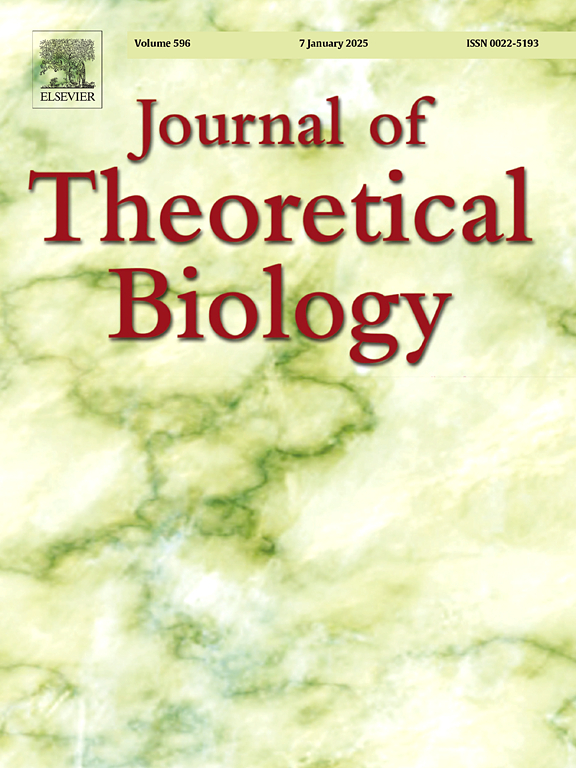Choice of landscape discretisation method affects the inferred rate of spread in wildlife disease spread models
IF 1.9
4区 数学
Q2 BIOLOGY
引用次数: 0
Abstract
Disease modelling at the livestock-wildlife interface is an important topic for which discrete-space models are used for the wildlife component. One prominent example is African Swine Fever, where wild boar play an influential role as reservoirs of disease spillover into domestic pig farms. In this paper, we present a simulation study that demonstrates the impact of seemingly arbitrary choices of landscape discretisation method on the inferred rate of spread within the model. We use an ordinary differential equation model to implement a simplified model of disease transmission between discrete groups of wild boar with spillover into domestic pig farms contained within a homogeneous landscape. We examine a range of scenarios whereby the landscape is discretised into wild boar patches of varying size and shape, and compare the rate of spread between domestic pig farms placed at fixed points on the landscape. Our results demonstrate a non-monotonic relationship between patch size and rate of spread, which is particularly unstable and unpredictable for square and triangular shaped patches. Discretisation of the landscape into hexagons appears to produce a more stable relationship between patch size and rate of spread for the three types of transmission kernel we investigated. Although the rate of disease spread does converge to a stable value, this occurs at patch sizes that are much smaller than would be used in practice for wild boar. We conclude that outputs of disease models containing a wildlife component should not be considered to be robust to arbitrary choices for patch size and placement, but rather as a source of uncertainty to be examined using sensitivity analysis. Furthermore, we strongly recommend the use of hexagons rather than squares or right triangles for landscape discretisation.
景观离散化方法的选择会影响野生动物疾病传播模型的推断传播速度。
家畜与野生动物交界处的疾病建模是一个重要课题,其中野生动物部分采用离散空间模型。其中一个突出的例子是非洲猪瘟,野猪作为疫病传播源对国内养猪场的影响很大。在本文中,我们介绍了一项模拟研究,展示了看似任意选择的景观离散化方法对模型内推断传播速度的影响。我们使用常微分方程模型来实现离散野猪群之间的疾病传播简化模型,并将其外溢到包含在同质景观中的家猪场。我们研究了将地貌离散为大小和形状各异的野猪斑块的一系列方案,并比较了位于地貌上固定点的家猪场之间的传播速度。我们的研究结果表明,斑块大小与扩散速度之间存在非单调关系,尤其是正方形和三角形斑块的扩散速度不稳定,难以预测。对于我们研究的三种传播内核,将地形离散化为六边形似乎能在斑块大小和传播速度之间产生更稳定的关系。虽然疾病传播率确实趋近于一个稳定值,但这是在斑块大小远小于野猪实际使用的情况下发生的。我们的结论是,包含野生动物成分的疾病模型的输出结果不应被视为对任意选择的斑块大小和位置具有稳健性,而应被视为不确定性的来源,并使用敏感性分析进行研究。此外,我们强烈建议使用六边形而不是正方形或直角三角形进行景观离散化。
本文章由计算机程序翻译,如有差异,请以英文原文为准。
求助全文
约1分钟内获得全文
求助全文
来源期刊
CiteScore
4.20
自引率
5.00%
发文量
218
审稿时长
51 days
期刊介绍:
The Journal of Theoretical Biology is the leading forum for theoretical perspectives that give insight into biological processes. It covers a very wide range of topics and is of interest to biologists in many areas of research, including:
• Brain and Neuroscience
• Cancer Growth and Treatment
• Cell Biology
• Developmental Biology
• Ecology
• Evolution
• Immunology,
• Infectious and non-infectious Diseases,
• Mathematical, Computational, Biophysical and Statistical Modeling
• Microbiology, Molecular Biology, and Biochemistry
• Networks and Complex Systems
• Physiology
• Pharmacodynamics
• Animal Behavior and Game Theory
Acceptable papers are those that bear significant importance on the biology per se being presented, and not on the mathematical analysis. Papers that include some data or experimental material bearing on theory will be considered, including those that contain comparative study, statistical data analysis, mathematical proof, computer simulations, experiments, field observations, or even philosophical arguments, which are all methods to support or reject theoretical ideas. However, there should be a concerted effort to make papers intelligible to biologists in the chosen field.

 求助内容:
求助内容: 应助结果提醒方式:
应助结果提醒方式:


